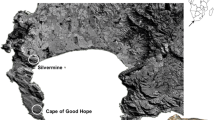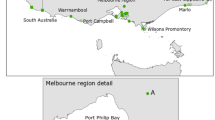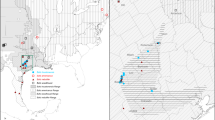Abstract
More amphibians are threatened through loss of habitat than any other single factor. Conservation measures to restore habitat are dependent on historical data indicating the original extent of a species. When historical data is absent, disjunct distributions create a special problem for conservationists who need to determine whether they have an anthropogenic cause. The Endangered western leopard toad (Amietophrynus pantherinus) has a disjunct distribution in the south-western tip of South Africa. We use mitochondrial sequences from 153 individuals to show that the disjunct distribution is unlikely to have an anthropogenic origin. Two distinct populations are separated by 100 km, with highest probability for the most recent common ancestor arising some 5 Kya. The causes of this disjunct distribution appear to be too recent to be attributable to changes in sea level; instead we suggest that there was a range retraction associated with a distinct drying period in the area during the Holocene, possibly indicating that this species will be susceptible to future climate change. Further, we find that the eastern population is less genetically diverse and appears to be undergoing a serious reduction in range, despite its occurrence in the least urbanized habitat. Conservation measures suggested include surveys for breeding sites in the eastern population, custodian agreements for existing breeding sites and foraging areas and the need for a Biodiversity Management Plan to be drawn up and implemented.


Similar content being viewed by others
References
Arens P, Van der Sluis T, Van’t Westende WPC, Vosman B, Vos CC, Smulders MJM (2007) Genetic population differentiation and connectivity among fragmented Moor frog (Rana arvalis) populations in The Netherlands. Landsc Ecol 22:1489–1500
Avise JC (2000) Phylogeography: the history and formation of species. Harvard University Press, Cambridge
Bandelt H-J, Forster P, Röhl A (1999) Median-joining networks for inferring intraspecific phylogenies. Mol Biol Evol 16:37–48
Baxter AJ, Meadows ME (1999) Evidence for Holocene sea level change at verlorenvlei, western cape, South Africa. Quart Int 56:65–79
Blaustein AR, Wake DB, Sousa WP (1994) Amphibian declines: judging stability, persistence, and susceptibility of populations to local and global extinctions. Conserv Biol 8:60–71
Bruford MW, Hanotte O, Brookfield JFY, Burke T (1992) Singlelocus and multilocus DNA fingerprint. In: Ha R (ed) Molecular genetic analysis of populations: a practical approach. IRL Press, Oxford, pp 225–270
Cabe PR, Page RB, Hanlon TJ, Aldrich ME, Connors L, Marsh DM (2007) Fine-scale population differentiation and gene flow in a terrestrial salamander (Plethodon cinereus) living in continuous habitat. Heredity 98:53–60
Calvalcanti MJ (2005) Mantel for windows, version 1.18. Freeware available at http://life.bio.sunysb.edu/morph/
Chase BM, Meadows ME (2007) Late quaternary dynamics of southern Africa’s winter-rainfall zone. Earth Sci Rev 84:103–138
Cherry MI (1992a) Body size, age and reproduction in the leopard toad, Bufo pardalis. J Zool Lond 228:41–50
Cherry MI (1992b) Sexual selection in the leopard toad, Bufo pardalis. Behaviour 120:164–176
Cowling RM, MacDonald IAW, Simmons MT (1996) The cape Peninsula, South Africa: physiographical, biological and historical background to an extraordinary hot-spot of biodiversity. Biodivers Conserv 5:527–550
Cunningham M, Cherry MI (2004) Molecular systematics of African 20-chromosome toads (Anura: Bufonidae). Mol Phylogenet Evol 32:671–685
Daszak P, Cunningham AA, Hyatt AD (2003) Infectious disease and amphibian population declines. Divers Distrib 9:141–150
de Villiers A (2004a) Species account: Bufo pantherinus A. Smith 1828. In: Minter LR, Burger M, Harrison JA, Bishop PJ, Braack H (eds) Atlas and red data book of the frogs of South Africa, Lesotho and Swaziland. Smithsonian Institution Press, Washington, DC, pp 71–74
de Villiers A (2004b) Species account: Xenopus gilli Rose and Hewitt, 1927. In: Minter LR, Burger M, Harrison JA, Bishop PJ, Braack H (eds) Atlas and red data book of the frogs of South Africa, Lesotho and Swaziland. Smithsonian Institution Press, Washington, DC, pp 260–263
Driver A, Maze K, Rouget M, Lombard AT, Nel J, Turpie JK, Cowling RM, Desmet P, Goodman P, Harris J, Jonas Z, Reyers B, Sink K, Strauss T (2005) National spatial biodiversity assessment 2004: priorities for biodiversity conservation in South Africa. South African National Biodiversity Institute, Pretoria
Duellman W, Trueb L (1986) Biology of amphibians. McGraw-Hill, New York
Dupanloup I, Schneider S, Excoffier L (2002) A simulated annealing approach to define the genetic structure of populations. Mol Ecol 11:2571–2581
Eick BN, Harley E, Cherry MI (2001) Molecular analysis supports specific status for Bufo pardalis and Bufo pantherinus. J Herp 35:113–114
Evans BJ, Morales JC, Picker MD, Kelly DB, Melnick DJ (1997) Comparative molecular phylogeography of two Xenopus species, X. gilli and X. laevis, in the south-western cape province, South Africa. Mol Ecol 6:333–343
Excoffier L, Smouse PE, Quattro JM (1992) Analysis of molecular variance inferred from metric distances among DNA haplotypes: application to human mitochondrial DNA restriction data. Genetics 131:479–491
Funk WC, Donnelly MA, Lips KR (2005) Alternative views of amphibian toe-clipping. Nature 431:433
Gagné SA, Fahrig L (2007) Effect of landscape context on anuran communities in breeding ponds in the National Capital Region, Canada. Landsc Ecol 22:205–215
Gouws G, Stewart BA, Daniels SR (2004) Cryptic species within the freshwater isopod Mesamphisopus capensis (Phreatoicidea: Amphisopodidae) in the western Cape, south Africa: allozyme and 12S rRNA sequence data and morphometric evidence. Biol J Linn Soc 81:235–253
Harrison AD (1962) Hydrobiological studies on alkaline and acid still waters in the western Cape province. Trans R Soc South Afr 36:213–243
Hey J, Nielsen R (2007) Integration within the felsenstein equation for improved markov chain Monte Carlo methods in population genetics. Proc Natl Acad Sci USA 104:2785–2790
Hu Y-L, Wu X-B, Jiang Z-G, Yan P, Su X, Cao S-Y (2007) Population genetics and phylogeography of Bufo gargarizans in China. Biochem Genet 45:697–711
Husté A, Clobert J, Miaud C (2006) The movements and breeding site fidelity of the natterjack toad (Bufo calamita) in an urban park near Paris (France) with management recommendations. Amphib Reptil 27:561–568
IUCN, Conservation International, NatureServe (2006) Global amphibian assessment. <www.iucnredlist.org/amphibians>. Downloaded on 6 Oct 2008
Jehle R, Burke T, Arntzen JW (2005) Delineating fine-scale genetic units in amphibians: probing the primacy of ponds. Conserv Genet 6:227–234
Knutson MG, Sauer JR, Olsen DA, Mossman MJ, Hemesath LM, Lannoo MJ (1999) Effects of landscape composition and wetland fragmentation on frog and toad abundance and species richness in Iowa and Wisconsin, USA. Conserv Biol 13(143):7–1446
Lambeck K (2004) Sea-level change through the last glacial cycle: geophysical, glaciological and palaeogeographic consequences. C R Geosci 336:677–689
Macey JR, Schulte JA, Larson A, Fang Z, Wang Y, Tuniyev BS, Papenfuss TJ (1998) Phylogenetic relationships of toads in the Bufo bufo species group from the eastern escarpment of the Tibetan plateau: a case of vicariance and dispersal. Mol Phylogenet Evol 9:80–87
Manel S, Schwartz MK, Luikart G, Taberlet P (2003) Landscape genetics: combining landscape ecology and population genetics. Trends Ecol Evol 18:189–197
Marsh DM, Trenham PC (2000) Metapopulation dynamics and amphibian conservation. Conserv Biol 15:40–49
Martinez-Solano I, Gonzalez EG (2008) Patterns of gene flow and source-sink dynamics in high altitude populations of the common toad Bufo bufo (Anura: Bufonidae). Biol J Linn Soc 95:824–839
Millennium Ecosystem Assessment (2005) Ecosystems and human well-being: biodiversity synthesis. World Resources Institute, Washington, DC, p 86
Minter L, Harrison J (2004) Amietophrynus pantherinus. In: IUCN 2009. IUCN red list of threatened species. Version 2009.1. www.iucnredlist.org
Minter LR, Burger M, Harrison JA, Braack HH, Bishop PJ, Knoepfer D (eds) (2004) Atlas and red data book of the frogs of South Africa, Lesotho and Swaziland. Smithsonian Institution Press, Washington, DC
Mucina L, Rutherford M (eds) (2006) The vegetation of South Africa, Lesotho and Swaziland. SANBI, Pretoria
Mucina L, Adams JB, Knevel IC, Rutherford MC, Powrie LW, Bolton JJ, van der Merwe JHJ, Anderson RJ, Bornman TG, le Roux A, Janssen JAM (2006) Coastal vegetation of South Africa. In: Mucina L, Rutherford M (eds) The vegetation of South Africa, Lesotho and Swaziland. SANBI, Pretoria, pp 658–697
Myers N, Mittermeier R, Mittermeier C, Fonseca GD, Kent J (2000) Biodiversity hotspots for conservation priorities. Nature 403:853–858
Newman RA, Squire T (2001) Microsatellite variation and fine scale population structure in the wood frog (Rana sylvatica). Mol Ecol 10:1087–1100
Noël S, Ouellet M, Galois P, Lapointe F-J (2007) Impact of urban fragmentation on the genetic structure of the eastern red-backed salamander. Conserv Genet 8:599–606
Parris KM (2006) Urban amphibian assemblages as metacommunities. J Anim Ecol 75:757–764
Passmore NI (1977) Bufo pardalis (Anura: Bufonidae): mating call and calling behaviour. Zool Afr 12:234–236
Pellet J, Guisan A, Perrin N (2004) Impact of urban fragmentation on the genetic structure of the eastern red-backed salamander. Conserv Biol 18:1599–1606
Phillips BL, Brown GP, Webb JK, Shine R (2006) Invasion and the evolution of speed in toads. Nature 439:803
Picker MD (1993) Embryonic tolerance of Xenopus (Anura) to acidic blackwater. Copeia 4:1072–1081
Pletscher DH, Schwartz MK (2000) The tyranny of population growth. Conserv Biol 14:1918–1919
Pounds JA, Bustamante MR, Coloma LA, Consuegra JA, Fogden MPL, Foster PN, Marca EL, Masters KL, Merino-Viteri A, Puschendorf R, Ron SR, Sánchez-Azofeifa GA, Still CJ, Young BE (2006) Widespread amphibian extinctions from epidemic disease driven by global warming. Nature 439:161–167
Poynton JC, Lambiris AJL (1998) On Bufo pantherinus A. Smith, 1828 (Anura: Bufonidae), the leopard toad of the southwestern Cape, South Africa, with the designation of a neotype. Afr J Herp 47:3–12
Rourke JP (1972) Taxonomic studies on Leucospermum R. BR. J South Afr Bot Suppl 8:1–191
Rourke JP (1984) A revision of the genus Mimetes Salisb (Proteaceae). J South Afr Bot 50:171–236
Rubbo MJ, Kiesecker JM (2005) Amphibian breeding distribution in an urbanized landscape. Conserv Biol 19:504–511
Schneider S, Roessli D, Excoffier L (2000) Arlequin: a software for population genetics data analysis. Genetics and Biometry Lab, Department of Anthropology, University of Geneva, Geneva
Semlitsch RD (2008) Differentiating migration and dispersal processes for pond-breeding amphibians. J Wildl Manage 72:260–267
Shaffer HB, Fellers GM, Magee A, Voss SR (2000) The genetics of amphibian declines: population substructure and molecular differentiation in the Yosemite toad, Bufo canorus (Anura, Bufonidae) based on single-strand conformation polymorphism analyis (SSCP) and mitochondrial DNA sequence data. Mol Ecol 9:245–257
Smith MA, Green DM (2005) Dispersal and the metapopulation paradigm in amphibian ecology and conservation: are all amphibian populations metapopulations? Ecography 28:110–128
Smith MA, Green DM (2006) Sex, isolation and fidelity: unbiased long-distance dispersal in a terrestrial amphibian. Ecography 29:649–658
Stuart SN, Chanson JS, Cox NA, Young BE, Rodrigues ASL, Fischman DL, Waller RW (2004) Status and trends of amphibian declines and extinctions worldwide. Science 306:1783–1786
Swart BL, Tolley KA, Matthee CA (2009) Climate change drives speciation in the southern rock agama (Agama atra) in the cape Floristic region. South Afr J Biogeogr 36:78–87
Swartz ER, Skelton PH, Bloomer P (2007) Sea-level changes, river capture and the evolution of populations of the Eastern Cape and fiery redfins (Pseudobarbus afer and Pseudobarbus phlegethon, Cyprinidae) across multiple river systems in South Africa. J Biogeogr 34:2086–2099
Sztatecsny M, Schabetsberger R (2005) Into thin air: vertical migration, body condition, and quality of terrestrial habitats of alpine common toads, Bufo bufo. Can J Zool 83:788–796
Trinder-Smith TH, Cowling RM, Linder HP (1996) Profiling a desieged flora: endemic and threatened plants of the cape Peninsula, South Africa. Biodivers Conserv 5:575–589
van Andel TH (1989) Late pleistocene sea levels and the human exploitation of the shore and shelf of southern South Africa. J Field Archaeol 16:133–155
Wardlaw BR, Quinn TM (1991) The record of Pliocene sea-level change at Enewetak Atoll. Quat Sci Rev 10:247–258
Acknowledgments
This project received funding from SANBI Applied Biodiversity Research, Molecular Ecology group. Field work was carried out under a CapeNature permit (#AAA004-00090-0035) and received an ethical clearance certificate (# 0001/08 from SANBI Ethics Committee). We are grateful to the many volunteers and professionals who have passed on toad carcasses and tissue samples used in this study, especially: Maya Beukes, Atherton de Villiers, Mark Day, Cliff and Suretha Dorse, Farrah Feldman, Grant Forbes, Dalton Gibbs, Sandra Hollerman, Kareemah Jacobs, Suzie Jirachareonkul and Evanne Rothwell. Thanks also go to Brian Chase, Michael Cunningham, Atherton de Villiers, Tony Rebelo and Andrew Turner for helpful discussions. An anonymous reviewer gave insightful comments on an earlier draft manuscript. SANBI field and lab work was greatly helped by Lucas Chauke, Keshni Gopal, Kevin Hopkins and Jenny Underhill.
Author information
Authors and Affiliations
Corresponding author
Rights and permissions
About this article
Cite this article
Measey, G.J., Tolley, K.A. Investigating the cause of the disjunct distribution of Amietophrynus pantherinus, the Endangered South African western leopard toad. Conserv Genet 12, 61–70 (2011). https://doi.org/10.1007/s10592-009-9989-7
Received:
Accepted:
Published:
Issue Date:
DOI: https://doi.org/10.1007/s10592-009-9989-7




